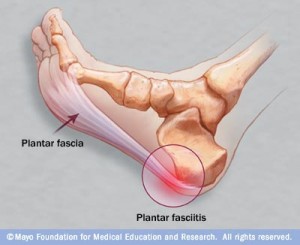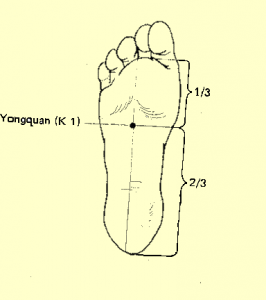Plantar fasciitis is a painful condition that makes your feet hurt, especially with the first few steps after being off of them for a while. What’s happening here? First, we have to understand fascia. It’s a system of connective tissue that holds us together.
Each muscle fiber has connective tissue, called fascia, surrounding it like a layer of Saran wrap.
Connective tissue (white) and muscle fibers. In plantar fasciitis, those fibers get tight and brittle.
It may help to picture a muscle fiber as a new drinking straw in a paper wrapper. The straw is actually the muscle cell, while the white paper is fascia. At each end, that flap of fascia becomes our tendons. It attaches to bone – or, more precisely, to the fascia surrounding bone. These sheaths of fascia are supposed to slide past each other as muscles move. With long periods of no movement, if the muscles are tight, or if there’s an injury, they can stick together and form a fascial adhesion.
When the plantar fascia (the fascia on the bottom of the foot) doesn’t move, it gets stiff and brittle, causing plantar fasciitis. When you do move, it hurts like crazy! The immediate answer – the one most old-fashioned podiatrists give – is to stop the movement. They prescribe stiff orthotics and walking-boot-type shoes that prevent your feet from flexing. That approach does give short-term relief, but in the long run it just sets you up for more pain.
Instead, advanced podiatrists like Dr. Ray McClanahan recognize that our feet evolved to be mobile. For millennia, they were a wide, stable base for our bodies that responded to uneven ground. Most modern footwear is too stiff and constricting, which restricts both toe movement and foot flexing, and reduces us to balancing on a solid block. The best long-term fix for plantar fasciitis is to get things moving again!

The entire bottom of the foot can hurt, although pain is usually focused in the heel.
That means:
1) Gradually changing to more minimal, flexible footwear. In some cases, toe spreaders will be useful.
2) Strengthen the feet with exercises (more here!). The muscles that create the arch of your foot are actually in your lower legs (they have long tendons down to the bones in the foot). Myofascial release for your legs will be helpful, too. With a little work, your legs and feet will support you as nature intended.
3) Break up the adhesions in the feet, using any combo of myofascial massage, acupuncture, rolling with small balls, etc. You have to do this a little bit at a time. Some people like to get in and dig the adhesions apart, deep-tissue massage style. That works well in the short term, but it also causes inflammation… which causes scar tissue and fascial adhesions to form… putting you back where you started. Myofascial release uses a more subtle massage approach to slide the layers apart. I love doing this type of work because the result is immediate freedom of movement and no boomerang side-effects.
The good news: It stops hurting immediately, and the relief is powerful and swift.
NOTE: This is how to treat the underlying problem – stiff fascia. If you are in a painful flare right now, we need to treat the “hot” injury first. That means (just as with any tendonitis) rest, ice, acupuncture and anti-inflammatory help via the diet or a topical medication.
Come see me and let me treat your plantar fasciitis. Won’t it be nice to go for a walk without pain again? I’ll be happy to help you assess your current shoes (sometimes there are tweaks we can make to give you more space in them) or pics of those you are considering on the internet!

